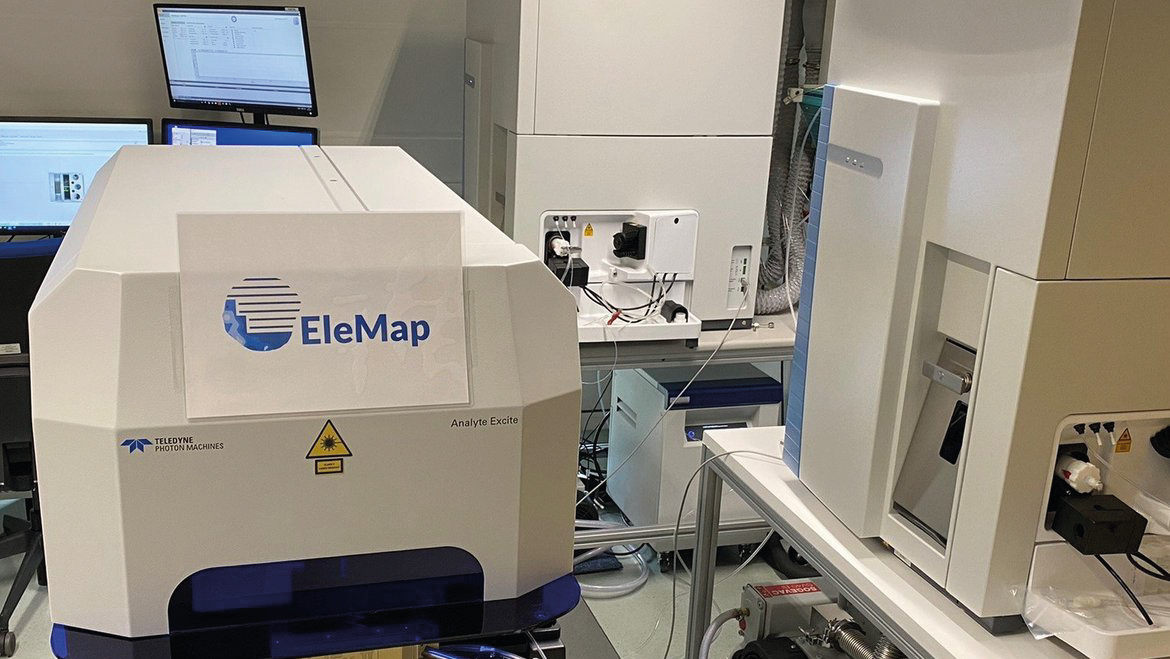EleMap - Elemental mapping by LA-ICP-MS
Contact:
Web:
Infrastructure belongs to:
The EleMap Lab is devoted to in situ analyses of minor and trace elements in minerals and other geological materials. We have a Teledyne Analyte Excite 193 nm excimer laser coupled to a Thermo Scientific iCAP RQ quadrupole ICP-MS and a Thermo Scientific iCAP TQ quadrupole ICP-MS, which can filter masses through the use of a reaction cell (MS/MS). The Laser system delivers a fully homogenized laser beam which ensures uniform ablation across the entire range of spot sizes with ns pulse length (< 4 ns). The repetition rate is fully adjustable between 1 and 300 Hz with beamsize on the sample between 2 and 150 microns.
Our differential is the added capability for efficient high spatial resolution chemical mapping. The fully synchronized stage motion, combined with fast washout times, make precision depth profiling of spots, lines and areas possible and enables high spatial resolution elemental mapping. Furthermore, the laser system is equipped with the fast wash out system ARIS (aerosol rapid introduction system) and a HelEx II two volume cell with an accurate stage travel within 1 micron.
Current capabilities are mapping, spot and profile analyses of elemental concentration for nearly the whole periodic table. Routine analyses can be done for Sulphides: Chalcopyrite, Pyrite, Galena, Sphalerite; Oxides: Rutile; Silicates: Zircon, Titanite; and Glasses. Further information on how to apply for analyses as well as the corresponding sample list, can be found on the laboratory's website.
Categories
Disciplinary Keywords
Instrumentation
Laboratory instrumentation
Instrument
-
Laser Ablation Inductively Coupled Plasma Mass Spectrometer
The Laser ablation inductively coupled plasma mass spectrometry is a technique used for the in situ analysis of trace elements in solid samples. It can determine many elements in the periodic table to high degrees of accuracy and precision. The technique complements electron microprobe analysis, typically measuring trace elements at a lower concentration range (1 ppb - 100 ppm). Solid particles are physically ablated due to the interaction of a high power (> 1 x 1010 Wcm-2) laser beam with the surface of the sample. The particles are carried in a stream of inert gas (helium or argon) into an argon plasma where they are ionized before measurement in a quadruple mass spectrometer. Isotopes are measured to determine elemental concentrations. Additional information available at "http://www.geo.uu.nl/Research/Petrology/what.htm" [Summary provided by Universiteit Utrecht] (Source: Global Change Master Directory (GCMD). 2023. GCMD Keywords, Version 16.3. Greenbelt, MD: Earth Science Data and Information System, Earth Science Projects pision, Goddard Space Flight Center (GSFC) National Aeronautics and Space Administration (NASA). URL (GCMD Keyword Forum Page): https://forum.earthdata.nasa.gov/app.php/tag/GCMD+Keywords)
Link
Key Publication
Relationships
- is part of
